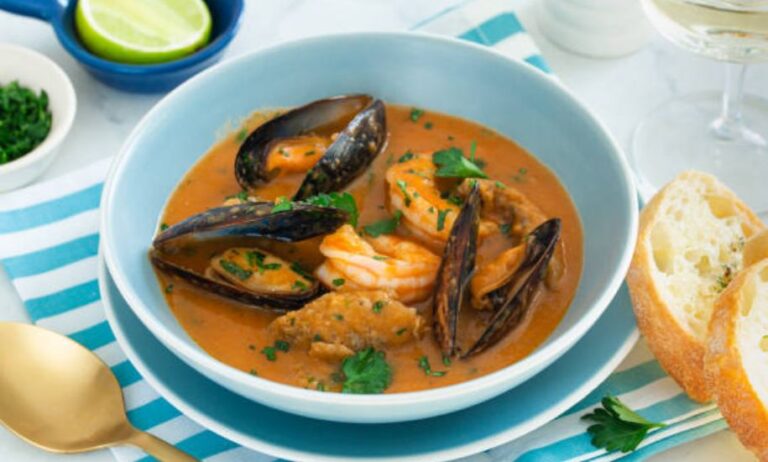From the Mediterranean shores of France comes one of the most celebrated and soul-warming seafood dishes in culinary history—the bouillabaisse recipe. At Flavoryo, we honor not just the flavor but also the cultural heritage that this traditional dish carries. Crafted with fragrant herbs, a medley of fresh seafood, and a saffron-infused broth, bouillabaisse recipe is more than just food—it’s an experience.
What is Bouillabaisse Recipe?
The bouillabaisse recipe originates from the port city of Marseille, France. Historically, fishermen would make this stew using unsellable fish, boiling them with seawater and local herbs. Over centuries, this humble stew evolved into a refined culinary treasure.
The word “bouillabaisse” is derived from the Provençal words bolhir (to boil) and abaissar (to simmer or reduce heat). This dual-step cooking technique—first boiling the broth and then simmering—remains at the heart of every bouillabaisse recipe today.
Core Ingredients of Bouillabaisse Recipe
Every authentic bouillabaisse recipe calls for a distinct blend of ingredients that define its depth and aroma. The magic of the dish lies in how these components work together.
Seafood Selection
-
Firm white fish such as monkfish, snapper, sea bass, or cod
-
Shellfish like mussels, clams, and shrimp
-
Crustaceans including crab or lobster (optional for premium versions)
Vegetables
-
Sliced leeks
-
Onions
-
Tomatoes (fresh or canned)
-
Fennel bulb
-
Potatoes (in some regional versions)
Aromatics and Herbs
-
Garlic
-
Orange zest or peel
-
Thyme
-
Bay leaves
-
Saffron threads (essential)
-
Parsley
Liquids and Oils
-
Olive oil
-
Dry white wine
-
Fish stock or water
Tools You’ll Need for Bouillabaisse Recipe
-
Large stock pot or Dutch oven
-
Strainer or sieve
-
Ladle
-
Mortar and pestle (for making rouille, if desired)
How to Make Bouillabaisse Recipe Step-by-Step
The bouillabaisse recipe may look complex, but it’s structured in clear stages. Here’s a detailed process that preserves tradition and maximizes flavor.
Step 1: Prepare the Broth
Start by sautéing chopped onions, leeks, and fennel in olive oil until they soften. Add minced garlic, orange peel, and chopped tomatoes. Stir until the mixture turns aromatic.
Add herbs—thyme, bay leaves, and saffron. Pour in the white wine and let it simmer to reduce. Add fish stock or water and bring everything to a boil. Let it cook for at least 30 minutes to infuse the broth with intense flavor.
Step 2: Add the Fish
Strain the broth to remove solids if you prefer a smoother texture. Return the liquid to the pot and bring it back to a boil. Now add the firmer white fish pieces and simmer for 10-15 minutes. Shellfish such as mussels or shrimp should be added in the last 5 minutes of cooking.
Step 3: Prepare the Rouille (Optional but Traditional)
Rouille is a garlicky, saffron-infused sauce served with the stew. Make it by grinding garlic, salt, saffron, and breadcrumbs together and mixing in olive oil slowly until you get a thick paste.
Step 4: Serve with Crusty Bread
Ladle the stew into shallow bowls. Add a dollop of rouille and serve with toasted slices of baguette. For a true Marseille-style presentation, you can serve the broth and fish separately.
Regional Variations of Bouillabaisse Recipe
Though the bouillabaisse recipe is rooted in Marseille, variations have emerged across regions and kitchens:
-
Marseille Style: Emphasizes red rascasse and scorpionfish, served in two courses—broth and then fish.
-
Modern Versions: Feature lobster, sea bass, or other premium seafood.
-
Home-Cooked Adaptations: Use local fish and skip the rouille for simplicity.
Bouillabaisse Recipe Tips for Best Flavor
-
Use multiple types of fish for depth and complexity.
-
Freshness is key. Always opt for the freshest seafood available.
-
Saffron is essential. Don’t skip it; it imparts the dish’s signature golden color and floral flavor.
-
Simmer, don’t boil. Once seafood is added, avoid high heat to preserve texture.
Common Mistakes in Bouillabaisse Recipe to Avoid
-
Overcooking the seafood. Fish and shellfish cook quickly; monitor them closely.
-
Skipping saffron. The dish is incomplete without it.
-
Using too few ingredients. Simplicity is good, but skimping on aromatics or seafood reduces richness.
Nutritional Value of Bouillabaisse Recipe
This dish is as nourishing as it is delicious. Packed with lean proteins, omega-3 fatty acids, and antioxidants from herbs and vegetables, a single serving of bouillabaisse recipe is:
-
High in protein
-
Low in carbohydrates
-
Rich in minerals like iodine and zinc
-
Contains heart-healthy fats from olive oil
Bouillabaisse Recipe vs. Other Fish Stews
What sets the bouillabaisse recipe apart from Italian cioppino or Spanish zarzuela is the use of saffron, the inclusion of rouille, and the two-stage cooking tradition. It’s less spicy than its Mediterranean cousins but far more aromatic and herbal.
Serving Ideas for Bouillabaisse Recipe
To complete your meal, serve your bouillabaisse recipe with:
-
Crusty sourdough or French baguette
-
Green salad with citrus vinaigrette
-
White wine such as Sauvignon Blanc or a dry Rosé
Why Bouillabaisse Recipe Is a Celebration Dish
Historically a fisherman’s meal, today the bouillabaisse recipe is associated with celebration, hospitality, and shared dining. From rustic kitchens in Provence to high-end restaurants in Paris, the dish has traveled far while keeping its roots intact.
It’s more than just a recipe—it’s a storytelling dish, woven through the traditions of Marseille and served as a symbol of unity, flavor, and identity.
